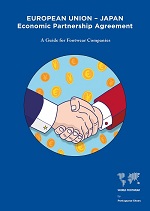Register to continue reading for free
EU-Japan EPA: a practical guide for footwear companies

The Economic Partnership Agreement between the European Union and Japan entered into force last year creating the largest open trade zone in the world. Today we bring you a practical guide for footwear companies
The European Union (EU) and Japan already had solid trade and economic ties: according to data by the Eurostat, in 2018, Japan was the 6th largest partner for EU exports of goods and the 7th largest partner for EU imports of goods. For Japan, the EU was the 3rd largest export destination (after the United States and China), with total exports in goods and services valued at 85 billion euros in 2016.
The EU is also a major investment partner for Japan: the EU is Japan's 2nd most important investment destination after the United States, accounting for almost 25% of the stock of Japanese outward FDI (Foreign Direct Investment) in 2016.
On the other side, Japan will benefit from the immediate removal of tariffs on several products, such as the categories of leather footwear. For many others, EU custom duties on footwear will initiate with tariffs around 17% and will be eliminated over 10 years, in most instances, and with a small group of tariff lines facing a 15 years transition period until complete elimination is reached.
The EU is also a major investment partner for Japan: the EU is Japan's 2nd most important investment destination after the United States, accounting for almost 25% of the stock of Japanese outward FDI (Foreign Direct Investment) in 2016.
Despite all the existing ties between the two areas, this trade agreement is ambitious by:
• Removing tariffs and other trade barriers and creating a platform to cooperate in order to prevent obstacles to trade;
• Helping shape global trade rules in line with high standards;
• Giving a powerful signal that two of the world's biggest economies reject protectionism.
The Economic Partnership Agreement removes the vast majority of the 1 billion euros of duties paid annually by EU companies exporting to Japan. Once the agreement is fully implemented, Japan will have scrapped customs duties on 97% of goods imported from the EU. The agreement also removes a number of long-standing non-tariff barriers, for example by endorsing international standards on cars. It will also break down barriers for key EU food and drink exporters to 127 million Japanese consumers and will increase export opportunities in a range of other sectors. According to estimates by the European Union, the annual trade between the EU and Japan could increase by nearly 36 billion euros once the agreement is implemented in full. The EU and Japan have also agreed to set ambitious standards on sustainable development, and the text includes for the first time a specific commitment to the Paris climate agreement. The agreement also secures the opening of services markets, in particular financial services, e-commerce, telecommunications and transport.
• Removing tariffs and other trade barriers and creating a platform to cooperate in order to prevent obstacles to trade;
• Helping shape global trade rules in line with high standards;
• Giving a powerful signal that two of the world's biggest economies reject protectionism.
The Economic Partnership Agreement removes the vast majority of the 1 billion euros of duties paid annually by EU companies exporting to Japan. Once the agreement is fully implemented, Japan will have scrapped customs duties on 97% of goods imported from the EU. The agreement also removes a number of long-standing non-tariff barriers, for example by endorsing international standards on cars. It will also break down barriers for key EU food and drink exporters to 127 million Japanese consumers and will increase export opportunities in a range of other sectors. According to estimates by the European Union, the annual trade between the EU and Japan could increase by nearly 36 billion euros once the agreement is implemented in full. The EU and Japan have also agreed to set ambitious standards on sustainable development, and the text includes for the first time a specific commitment to the Paris climate agreement. The agreement also secures the opening of services markets, in particular financial services, e-commerce, telecommunications and transport.
Footwear
Regarding footwear this agreement will be key for European and Japanese companies aiming to sell their products in the markets of Japan and the EU, respectively, given the competitiveness benefits arising from tariffs reduction and the scheduled elimination. According to the European Union, before the agreement, EU exporters were paying roughly 174 million euros in customs duties on leather and footwear products. This sector has traditionally been highly protected in Japan, with substantial tariffs of almost 30%.
Under the agreement, tariffs applied to European Union originating footwear entering Japan will be phased out over the next years. Tariffs on key leather products such as handbags will be eliminated over a decade, and the traditionally protected products with very high tariffs (27%), such as sports shoes and ski boots, will also be liberalised over the same period. On the other hand, with the entry into force of the agreement the immediate end of the quota system was applied for EU footwear exports which should bring significant gains for exporters of leather hides and skins.
On the other side, Japan will benefit from the immediate removal of tariffs on several products, such as the categories of leather footwear. For many others, EU custom duties on footwear will initiate with tariffs around 17% and will be eliminated over 10 years, in most instances, and with a small group of tariff lines facing a 15 years transition period until complete elimination is reached.
The World Footwear has prepared a document with an overview of the European Union - Japan Economic Partnership Agreement which you can DOWNLOAD free of charge:
Included within is also a PRACTICAL GUIDE FOR ALL FOOTWEAR COMPANIES based in Japan and in the European Union and aiming to trade under the current framework.







